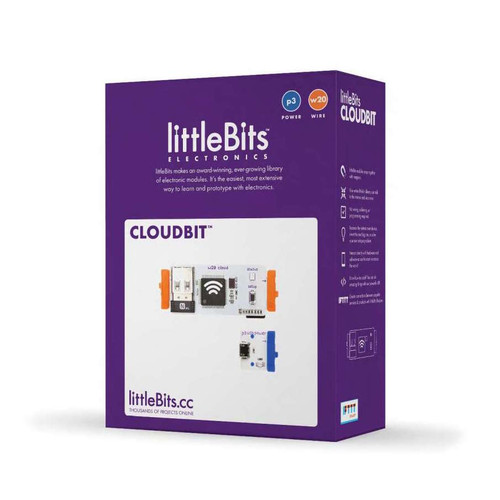
littleBits - CLOUDBIT
| SKU: | 1265 |
The cloudBit is the easiest way to create internet-connected devices. You can now snap the internet to anything! Retrofit your thermostat to control it remotely, or set up a sound-triggered alarm system that texts you alerts--the possibilities are endless. No programming, soldering or wiring required.
- Build anything, including a DIY Nest, SMS doorbell, and hundreds more ideas online!
Check out our Tips and Tricks for more ideas on using the cloudBit.
New to littleBits? Check out the cloudBit Starter Kit!
A quick note: The cloudBit needs a lot of juice, and only works with p3 usb power. Don't worry, the usb power AND a US wall adapter are included!
- Connect everything! Your entire littleBits library can talk to the internet and vice versa
- Automate with IFTTT to connect with any web service, like Facebook, Gmail and Twitter, or hardware like NEST and Phillips HUE
- Remote control and readout to control your circuits across the room or across the world
- Code with the cloud API or the littleBits Arduino module for further customization [optional]
- Includes usb power module, wall adapter and cable for robust installations
GEEK SPEAK
The cloudBit is a single board computer running Linux. We use an USB WiFi adapter for networking, and once commissioned we automatically connect to the littleBits cloud. Once connected the cloudBit sends the littleBits cloud samples of the voltage on the input bitSnap™ with 10-bit precision, and the littleBits cloud is able to instruct the cloudBit to set the voltage on it's output bitSnap.The RGB status LED lets you know what the cloudBit is doing. When it is purple the cloudBit is booting up, when it is yellow it is trying to connect to the WiFi access point, and when it has successfully connected to the littleBits cloud it turns green.
In order to tell the cloudBit what WiFi router to connect to you place it into "commissioning mode" by pressing and holding the setup button until the status LED turns blue.
When the cloudBit operates in commissioning mode it acts as an 802.11 access point and web server. When instructed by the user's browser the cloudBit scans for access points and returns the results to the browser for selection. Once the user sets up an access point the cloudBit enters normal mode.
When it operates in normal mode it attempts to connect to the configured access point and then communicates with the littleBits cloud over a TLS socket. If the cloudBit does become disconnected the status LED will turn red briefly, and then yellow as the cloudBit tries to automatically reconnect.
Once connected the litteBits cloud can instruct the cloudBit to output any voltage between 0V and 5V or any interval of time between 0 and 32 seconds.
UNDER THE HOOD
For the cloudBit we built an embedded Linux system based around a Freescale i.MX23 ARM926EJ-S processor. It has 64MB of RAM and boots a heavily modified version of the ArchLinux distribution from a 4GB SD card. The cloudBit uses an 802.11b/g/n USB adapter for networking, the Freescale's on-chip ADC and DAC for the input and output pins, and the GPIO pins for the setup button and the status LED. We've left pads on the bottom of the board so that you can connect to the cloudBit's serial console using 3.3V UART (8-N-1, 115,200 baud) and poke around.
The cloudbit currently supports networks with the following security standards: Open (no encryption), WEP, WPA and WPA2.
TECHNICAL SPECS
- Dimensions (mm):15.0(H) x 10.0(W) x 5.0(D)
- Product Weight:0.62 lbs (0.28 kg)
- Recommended Age:8+



